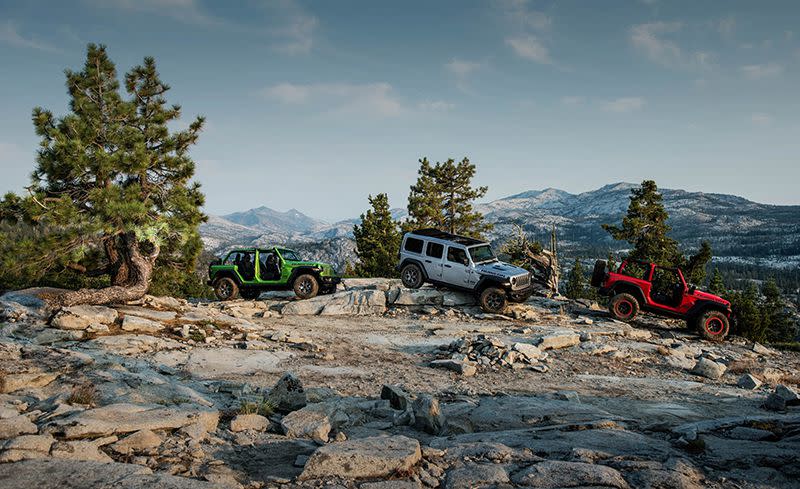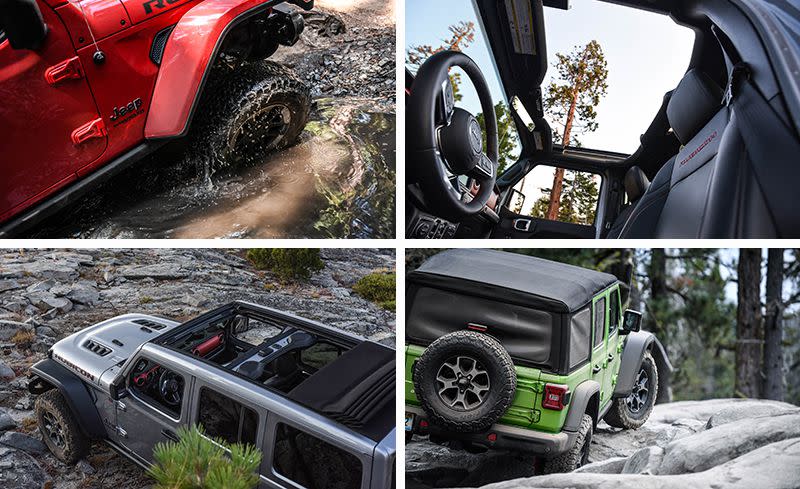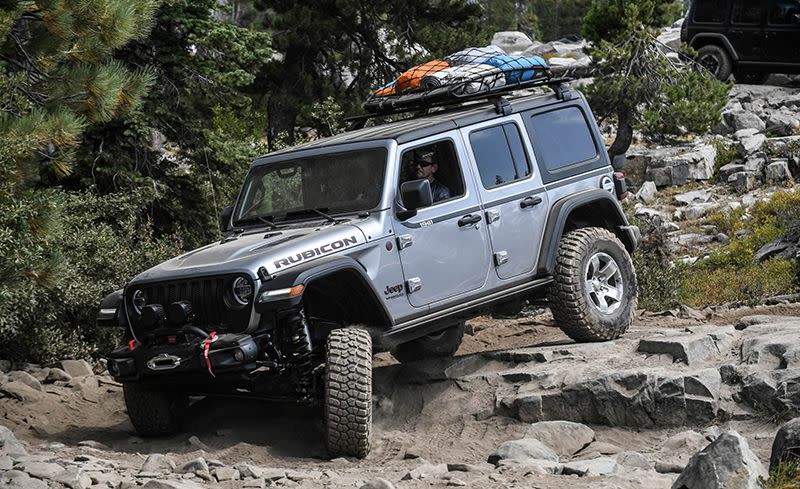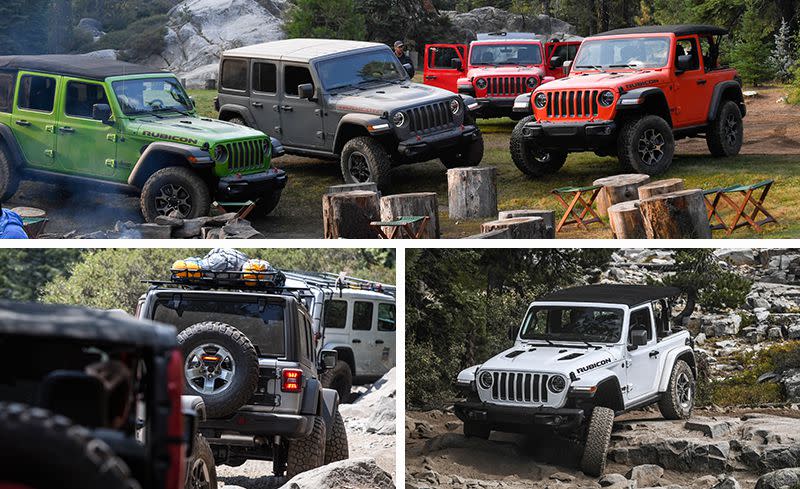Conquering the Rubicon Trail at 1 MPH is Vital to Jeep

Jeep needs the Rubicon Trail in the same way that Porsche needs Le Mans and Ferrari needs Formula 1. This rough and rocky 22-mile path across the mountains of the Sierra Nevada in northern California is where Jeeps earn their legitimacy, prove their ability, and gain marketing mojo. And, of course, it’s the origin of the name of the off-road-fortified 2018 Jeep Wrangler Rubicon.
So, Jeep choppered a couple dozen NAFTA-nation-based journalists, and some quasi-journalists wielding GoPros, from the soft comfort of the Ritz-Carlton at Lake Tahoe to the Rubicon trailhead at Wentworth Springs, put us in two-door Wrangler Rubicons and four-door Wrangler Unlimited Rubicons, and then led them in a closely controlled conga line across the trail. Those of us who had never been choppered anyplace before were suitably flattered. And then we slept on cots in tents that night to deflate our egos.
It took two full days to cover the trail at an average speed of about 1 mph. That’s one mile per hour-about a third of walking speed.
What’s surprising about taking the latest Wrangler Rubicon across the Rubicon is that the Jeep itself was the least impressive part of the trip. But it was still impressive.
Tool of the Moment
“I’ve done this trip in a flat-fender Jeep a bunch of times,” Jp Magazine editor Rick Péwé was telling anyone who would dare listen. “With a Go Devil four and a three-speed manual. This is nothing.” Hard-core Jeep folks love bragging about the miseries they’ve endured and overcome. The new Wrangler Rubicon, on the other hand, does make conquering much of the Rubicon’s nastiest terrain almost easy. Manageable enough even for us dazzling urbanites of the press corps to handle.
Running on 33-inch-tall BFGoodrich Mud-Terrain T/A KM3 tires (a more aggressive off-road tire than the standard BFG All-Terrain KO2s) with electronically locking front and rear differentials in the pumpkins of its beefy Dana 44 solid axles, the Rubicon model sits at the top of the new JL-generation range and makes up, says Jeep, about 28 percent of Wrangler sales. The most basic Wrangler Sport starts at $29,440, but it takes 10 grand more-$39,440-to get into a Rubicon. Go for the Wrangler Unlimited four-door, and that price trudges up to $42,940. Add a few options, like the $2000 eight-speed automatic transmission and $1295 steel bumpers, and $50,000 isn’t far away. In fact, many of the Wrangler Rubicons on this trek were priced up near $53,000 before being further laden with dealer-installable Mopar accessories.
“It’s a rock-crawling limousine,” I said to my driving companion on this trip, former C/D executive editor Steven Cole Smith, as we hauled our substantial spreads into the cushy leather seats of a red two-door. “There’s not much military left in here,” I added. He kind of grunted and said, “Good.”
While Jeep now offers a 270-hp turbocharged 2.0-liter inline-four augmented with the eTorque electric-motor assist as a $1000 option, all the Wrangler Rubicons we drove were powered by the familiar 285-hp 3.6-liter V-6 backed up by the automatic transmission. Like so many modern turbo fours, Jeep’s is tuned for low-end torque production and is rated at 295 lb-ft at 3000 rpm. The V-6, on the other hand, makes its peak 260 lb-ft at 4800 rpm. Only the V-6 can be had with a six-speed manual transmission. On the Rubicon Trail, the engine choice likely makes little difference, at least for rookies like us. Our entire trip was run with four-wheel drive engaged in low range, and seeing the tachometer needle pass 3000 rpm was an infrequent event.
Along the granite shelving where Jeep staged the start of the trek, the Wrangler two-door hardtop was sure-footed and even relatively quiet. While most trail vets run relatively low air pressures in their tires-well below 20 psi-the new Wranglers had their balloons set at more than 35 psi and sometimes rising beyond 40 psi. There wasn’t much squish in the tires; they couldn’t simply mold themselves to the contours of the rocks for additional contact patch.
Jeep’s Rubicon package includes electronic decoupling of the anti-roll bars to allow greater articulation of the live axles, and the bars remained disconnected during the entire trail run. There’s also easy electronic engagement of the differential locks, either both together or the rear alone. Only occasionally, in situations when a wheel or two would rise up off boulders or the like, was it necessary to use the lockers.
Motley Crew
With constant exposure to each other for about 20 hours, Smith and I had just about enough time to badmouth every other person who works in our industry. Twice. A few of them, three times. But this was a relatively jackass-free group of journalists on the trail including friends (and C/D contributors) Scott Oldham and Ben Stewart. “Here,” Oldham said, handing me a sandstone boulder about the size of a beagle while I rode shotgun alongside Smith. “Hold this. We’ll need it later.”
Free of graffiti and trash, with no apparent vandalism, the Rubicon Trail is almost pristine. There aren’t even noticeable streaks of Castrol GTX where punctured oil pans likely left them. Maintained and groomed by volunteer groups including Friends of the Rubicon, the trail is in a condition that’s a testament to the spirit of off-roaders. Meet another group of Jeeps coming in the opposite direction, and it’s a battle to see who can be the most courteous.
“Dang!” I cried out as the four-door Rubicon we drove on the second day slipped off a boulder and came crashing down on the Jeep’s fortified skid plates. “I think you killed it.” But he hadn’t. In fact, throughout the trip, none of the Wranglers showed any apparent damage.
This was a stark contrast with the true rock crawlers we met along the trail-ancient XJ Cherokees, the occasional Toyota pickup or FJ Land Cruiser, a few older Ford Broncos and Wranglers and CJs of all sorts-which were all beat to hell. If there had been one with more than a single undented body panel, it would have stood out. The Rubicon can be brutal to vehicles, and damage is to be expected. That’s why it was so nice to be driving vehicles still owned by FCA. If we screwed them up, so what? They could just build more. What testifies to the Wrangler Rubicon’s toughness is that at the end of the two-day adventure, none of them looked any the worse for wear. Still, I’d be reluctant to take on this trail in a $53K truck on which I still owed 71 payments.
Techno-Babylon
The Wrangler’s abilities are well known and well shown by the Rubicon. But by its nature it’s an eccentric. It’s not the easiest thing to get into and out of. Many of the controls are goofy. Depending which top it’s wearing (or not wearing), it can be loud. That it crawls over boulders well doesn’t equate to a great ride over a concrete freeway at speed. And when the cooling fan snaps on, the thing sounds like a hovercraft. But technology also helps the Wrangler. For instance, the rearview camera is a great tool on the trail. It’s so good that a similar camera for looking down on the rocks up front would be appreciated. The four-wheel-drive system is awesome, the decoupling anti-roll bars and push- button lockers are spectacular, but somehow driving across the Rubicon still feels like a personal, human accomplishment.
The Greatness Without
The Rubicon is a great test. If Ford’s new Bronco can’t get over this course, it’ll have a hard time justifying its existence. But what’s most impressive here is how much fun it is to go 1 mph for 22 miles with friends while meeting more people on the trail. It’s a spectacular drive as impressive in its own way as lapping the Nürburgring. And it’s a lot more involving than clinking wine glasses at The Quail during Monterey Car Week.
The Wrangler is as valuable to Jeep as the 911 is to Porsche. The company can’t afford to screw it up. But accidentally, or maybe intentionally, what Jeep showed off on this trip wasn’t just its product-it showed off the reason why it’s worthwhile to own a Wrangler Rubicon at all.
Incidentally, my friend Rick Péwé says he could cover the Rubicon in a Wrangler Sport, no sweat. With a couple of plug wires pulled.
('You Might Also Like',)

 Yahoo Autos
Yahoo Autos 



